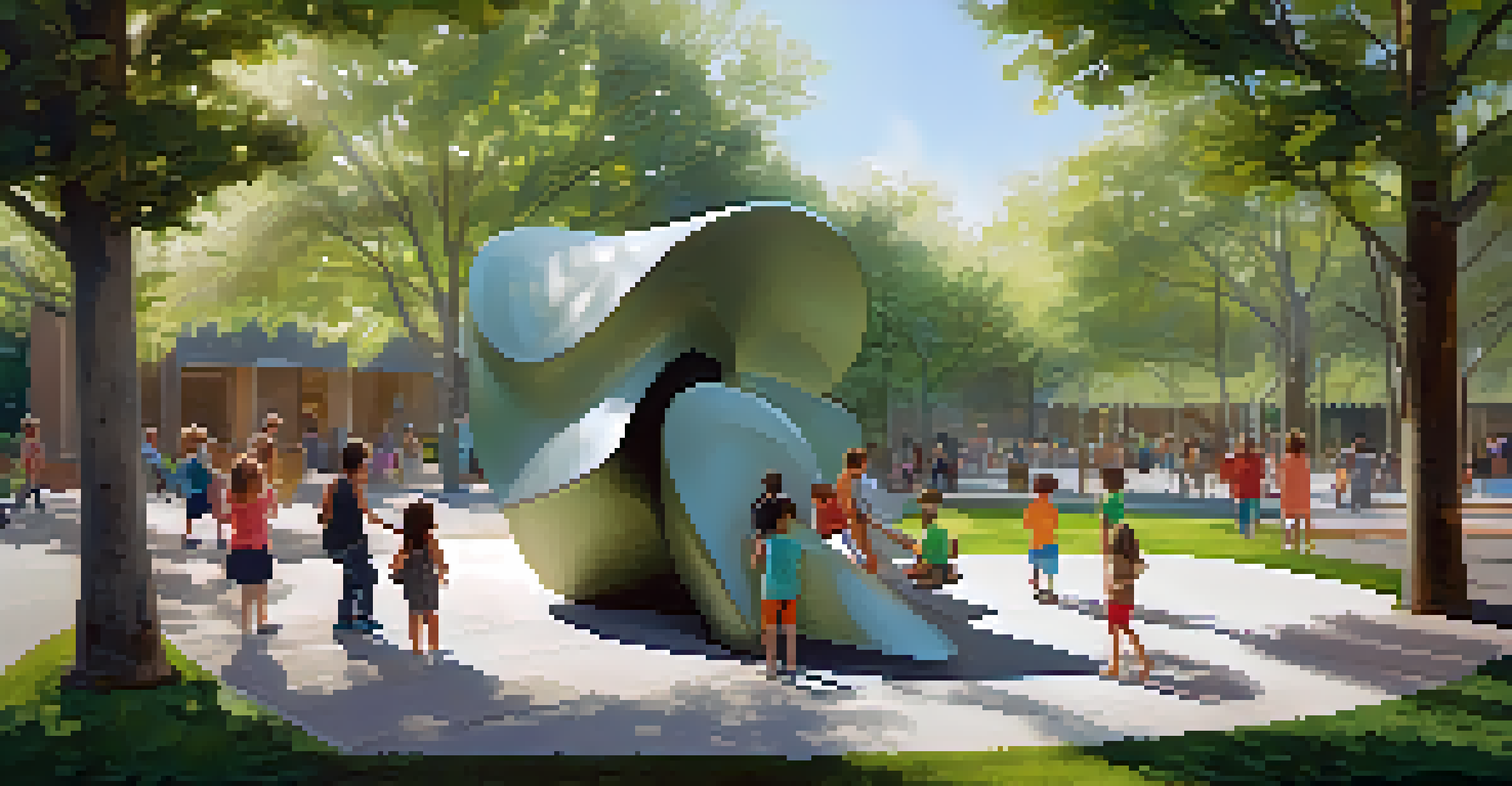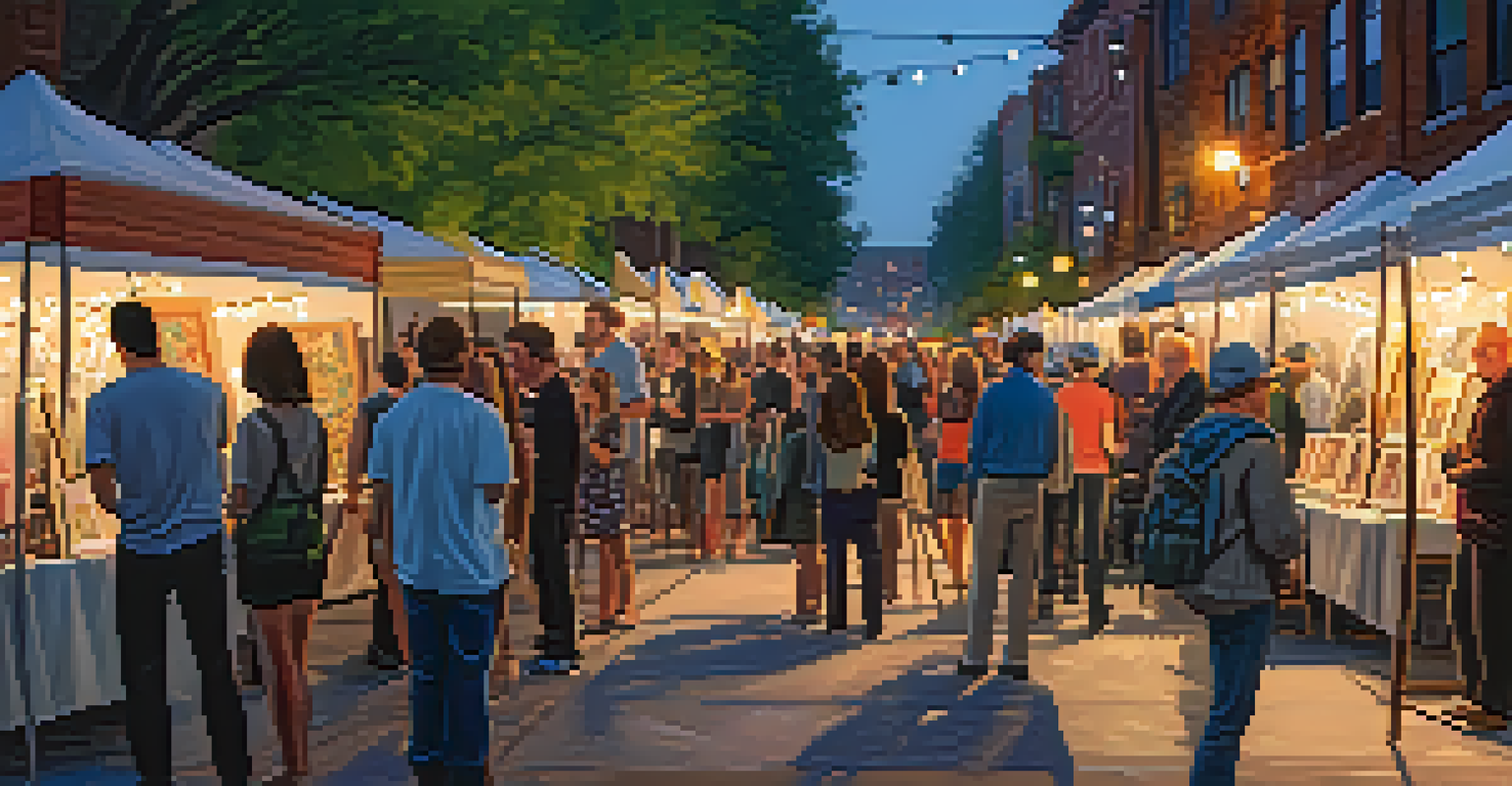Transforming Urban Landscapes: The Role of Public Art Installations

Understanding Public Art: A Catalyst for Change
Public art refers to artworks created for public spaces, often funded by the community or government. It serves as a bridge between art and everyday life, making creativity accessible to everyone. When placed strategically, these installations can transform neglected urban areas into vibrant gathering spaces that encourage interaction and celebration.
Art is not freedom from discipline, but disciplined freedom.
For instance, murals on blank walls can turn a dull street into an open-air gallery, appealing to both locals and tourists alike. This transformation not only beautifies the landscape but also fosters a sense of identity and pride among residents. Public art sparks conversations and encourages community engagement, reinforcing the idea that art is for everyone.
Moreover, public art can address social issues and reflect the culture of the community it inhabits. By showcasing local artists, these installations become a canvas for storytelling, allowing diverse voices to be heard and appreciated. In doing so, public art not only enhances aesthetics but also contributes to the social fabric of urban life.
The Impact of Public Art on Urban Revitalization
Urban revitalization often aims to breathe new life into declining neighborhoods, and public art plays a crucial role in this process. By introducing colorful and engaging installations, cities can attract visitors and stimulate local economies. A well-placed sculpture or mural can act as a landmark, drawing people to previously overlooked areas.

Take the case of the Wynwood Walls in Miami, where former warehouses were transformed into an artistic hub. This initiative not only revitalized the area but also turned it into a global destination for street art enthusiasts. Such transformations showcase how public art can serve as a powerful tool for urban regeneration.
Public Art Transforms Communities
Public art enhances urban spaces by fostering community pride and engagement, making art accessible to all.
Moreover, public art fosters a sense of community ownership and pride. When residents see their neighborhoods evolve through art, they’re more likely to invest in and care for their surroundings. This cycle of improvement creates a more vibrant, connected community, proving that art can be a catalyst for positive change.
Public Art and Community Engagement: A Symbiotic Relationship
Public art installations often encourage community engagement by inviting locals to participate in the creation process. Collaborative projects, such as community murals, allow residents to contribute their ideas and creativity, fostering a sense of belonging. This participatory approach not only beautifies the space but also strengthens community ties.
Public art is a reflection of society; it tells us who we are and what we value.
For instance, initiatives like 'Paint the Town' invite artists and community members to co-create murals that reflect local history and culture. These projects empower individuals, giving them a voice in the artistic narrative of their neighborhoods. As a result, public art becomes a reflection of the community’s identity, resonating deeply with its residents.
Additionally, events surrounding public art unveil opportunities for dialogue and interaction. Art walks, workshops, and festivals create a platform for residents to engage with artists and each other. Such gatherings promote unity and foster a vibrant community spirit, illustrating how art can bring people together in meaningful ways.
The Role of Technology in Modern Public Art Installations
Technology is reshaping public art in exciting ways, providing new mediums and platforms for artists to explore. Digital installations, augmented reality, and interactive displays introduce a dynamic element to urban landscapes. These innovations enable viewers to engage with art in ways that were previously unimaginable, transforming passive observation into active participation.
For example, installations that incorporate augmented reality allow viewers to use their smartphones to see additional layers of art or storytelling. This blend of technology and creativity not only captivates audiences but also attracts a younger demographic to public art. As a result, urban spaces become more lively and engaging.
Art Drives Urban Revitalization
Well-placed public art can attract visitors and stimulate local economies, breathing new life into declining neighborhoods.
Moreover, technology facilitates broader access to public art. Online platforms can showcase installations to global audiences, encouraging dialogue about local artists and their work. By merging technology with public art, cities can create immersive experiences that not only enhance their landscapes but also promote cultural exchange.
Public Art as a Reflection of Social Issues
Public art often serves as a powerful medium to address and reflect social issues. Artists use their work to comment on topics such as inequality, environmental concerns, and social justice. By bringing these issues into public view, art can provoke thought and inspire action within communities.
For instance, installations that focus on climate change or racial equality can raise awareness and spark conversations among passersby. These artworks can challenge perceptions and encourage individuals to engage with pressing societal challenges. In essence, public art becomes a mirror reflecting the community's values and concerns.
Furthermore, when art addresses social issues, it fosters empathy and understanding among diverse groups. This connection can bridge gaps between different cultures and encourage collective action towards positive change. In this way, public art not only beautifies urban landscapes but also cultivates social consciousness and responsibility.
Challenges in Implementing Public Art Projects
Despite its many benefits, implementing public art projects can come with challenges. Funding, bureaucratic hurdles, and community opposition can hinder the development of new installations. Securing financial support often requires extensive planning and collaboration among various stakeholders, which can be a daunting task.
Moreover, navigating the regulatory landscape can complicate the process. Local governments may have strict guidelines about what can be displayed in public spaces, leading to potential conflicts between artists and officials. These barriers can discourage creativity and limit the scope of public art initiatives.
Technology Enhances Public Art
Innovative technologies like augmented reality are transforming public art, making it more interactive and engaging for diverse audiences.
Community opposition can also pose a challenge, especially if residents feel disconnected from the artistic vision. Ensuring that public art resonates with local communities requires ongoing dialogue and engagement. By actively involving residents in the planning process, cities can overcome these challenges and create installations that truly reflect their neighborhoods.
The Future of Public Art in Urban Development
As cities continue to evolve, the future of public art in urban development looks promising. Increasingly, urban planners are recognizing the value of integrating art into cityscapes. This shift reflects a broader understanding that art enhances not only the aesthetic quality but also the social and economic vitality of urban areas.
Innovative projects that blend nature, technology, and public art are emerging, creating immersive experiences for residents and visitors alike. For example, parks that incorporate art installations alongside natural landscapes can provide tranquil spaces for relaxation and creativity. Such developments encourage a harmonious balance between urban life and nature.

Looking ahead, the role of public art in urban development will likely expand as cities strive to become more inclusive and vibrant. By prioritizing art in planning and development, cities can cultivate unique urban identities that reflect the diverse voices of their communities. Ultimately, public art will continue to play a significant role in shaping the future of urban landscapes.